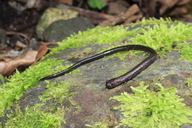|
Pseudoeurycea lineola (Cope, 1865)
Mexican Slender Salamander | family: Plethodontidae subfamily: Hemidactyliinae genus: Pseudoeurycea |
|
Taxonomic Notes: This species was long placed in Lineatriton, which molecular systematic analyses show to be deeply nested within one of two major clades of Pseudoeurycea, close to the generotype of that genus, P. leprosa. |
|
 © 2015 Sean Michael Rovito (1 of 17) |
|
|
|
Description L. lineolus can be distinguished from other wormlike salamanders by the long, narrow vertebrae it has. In all, the body contains fifteen elongated vertebrae. This species is usually a dull black, with paler coloration marking the sides, (Dunn 1926) although Shannon and Werler (1955) have documented living specimens that were uniformally lead gray (Tanner and Dundee, 2000). Distribution and Habitat Country distribution from AmphibiaWeb's database: Mexico
Comments Lineatriton comes from the Latin words "linea," which literally translates as "feminine," and "triton," the name of the Roman sea god. "Linea" refers to the slender appearance of the salamander. The species name, lineola, is also from "linea," but in this context, it refers to the thin vertebral line some individuals have (Tanner and Dundee 2000).
References
Dunn, E. R. (1926). ''Hydromantes.'' The Salamanders of the Family Plethodontidae. Smith College, Northhampton, Massachusetts, 344-354. Pelcastre-Villafuerte, L. and Flores-Villela, O. A. (1992). ''Lista de especies y localidades de recolecta de la herpetofauna de Veracruz, Mexico.'' Publication Espec. Museum Zoology Fac. Ciencias Universidad Nacional Autonoma de Mexico, (4), 26-96. Shannon, F .A. and Werler, J. E. (1955). ''Notes on amphibians of the Los Tuxtlas Range of Veracruz, Mexico.'' Transactions of the Kansas Academy of Science, 58, 360-386. Tanner, W. W. and Dundee, H. A. (2000). ''Lineatriton, L. lineolus.'' Catalogue of American Amphibians and Reptiles. Society for the Study of Amphibians and Reptiles, 705.1-705.4. Originally submitted by: Elizabeth Reisman (first posted 2003-11-14) Edited by: Vance T. Vredenburg (2008-01-13) Species Account Citation: AmphibiaWeb 2008 Pseudoeurycea lineola: Mexican Slender Salamander <https://amphibiaweb.org/species/4084> University of California, Berkeley, CA, USA. Accessed May 3, 2025.
Feedback or comments about this page.
Citation: AmphibiaWeb. 2025. <https://amphibiaweb.org> University of California, Berkeley, CA, USA. Accessed 3 May 2025. AmphibiaWeb's policy on data use. |


 Raffaëlli Account
Raffaëlli Account Map of Life
Map of Life